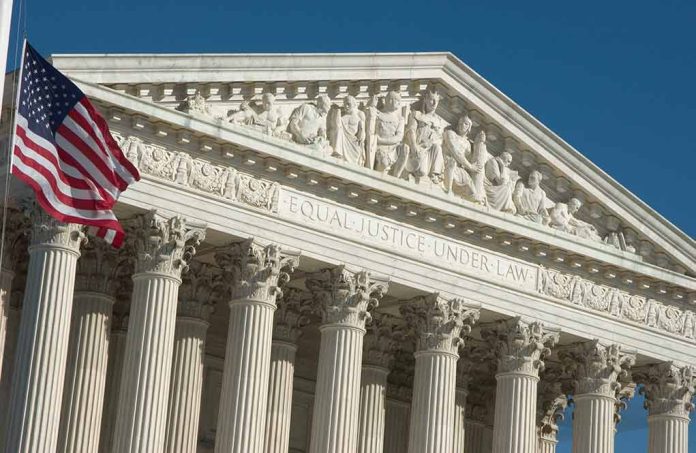🔴 Website 👉 https://u-s-news.com/
Telegram 👉 https://t.me/usnewscom_channel
The Supreme Court narrowly escapes a radical transformation as election results thwart Democrats’ court-packing plans.
At a Glance
- Republican Senate majority halts Democrat-led court-packing initiatives
- Supreme Court’s structure expected to remain unchanged for at least a decade
- Election results impact future rulings on abortion, gun rights, and administrative regulations
- State supreme court races prove crucial for election integrity across the nation
- Concerns over judicial ethics and transparency persist despite averted structural changes
Election Safeguards Supreme Court’s Integrity
The 2024 election has become a pivotal moment in American judicial history, effectively halting what many conservatives viewed as a looming threat to the Supreme Court’s integrity. With Republicans securing a majority in the Senate, ambitious plans to alter the Court’s composition have been decisively thwarted, preserving its current structure for the foreseeable future.
“The election means that court-packing schemes are now effectively scuttled despite the support of Democratic senators like Elizabeth Warren (D., Mass.) and Sheldon Whitehouse (D., R.I.). Given Kamala Harris’s reported support, the Supreme Court dodged one of the greatest threats to its integrity in its history,” notes legal scholar Jonathan Turley.
This outcome stands in stark contrast to the concerns raised during the 2020 election cycle when then-Senator Kamala Harris suggested potential reforms to the Supreme Court. Harris stated, “I do believe there should be some kind of reform of the court, and we can study what that actually looks like,” leaving many conservatives anxious about the future of the judiciary.
The Court-Packing Controversy
The concept of “court-packing” – increasing the number of justices to alter the Court’s ideological balance – has been a contentious issue in American politics. Democrats, frustrated with the Court’s conservative majority, had floated the idea as a means to counterbalance what they perceived as an ideological imbalance.
However, the 2024 election results have effectively ended this push. As Turley explains, “In this way, the election may prove the key moment in ending one of the most threatening periods of the court’s existence. With the loss of the control of the Senate, the push for new limits on the court and calls for investigations of conservative justices will subside for now.”
Implications for Future Rulings
The preservation of the Court’s current structure is expected to have far-reaching implications for American law and society. Turley predicts, “A younger generation will grow up in a country where the voters of each state are allowed to determine what limits to place on abortions. Likewise, gun rights and religious rights will continue to be robustly protected. The checks on the administrative state are also likely to be strengthened. Pushes for wealth taxes and other measures will likely receive an even more skeptical court.”
State Supreme Courts: The New Battleground
While the federal Supreme Court has avoided structural changes, state supreme courts have emerged as crucial battlegrounds for election integrity. With 33 states holding elections for 82 of the 344 nationwide seats in 2024, these races have taken on new significance in shaping the legal landscape at the state level.
Recent elections in Wisconsin and Pennsylvania have seen Democrats secure liberal majorities, potentially impacting future election-related decisions. Michigan’s upcoming state supreme court races are particularly pivotal, with the potential to shift the current 4-3 liberal majority.
A Preserved Institution
As the dust settles on the 2024 election, the Supreme Court emerges with its structure intact, dodging what some viewed as an existential threat. While debates about its composition and ethical standards are likely to continue, the institution’s fundamental role in American democracy remains unchanged. The coming years will undoubtedly test the Court’s resilience and adaptability in an ever-evolving political landscape.
